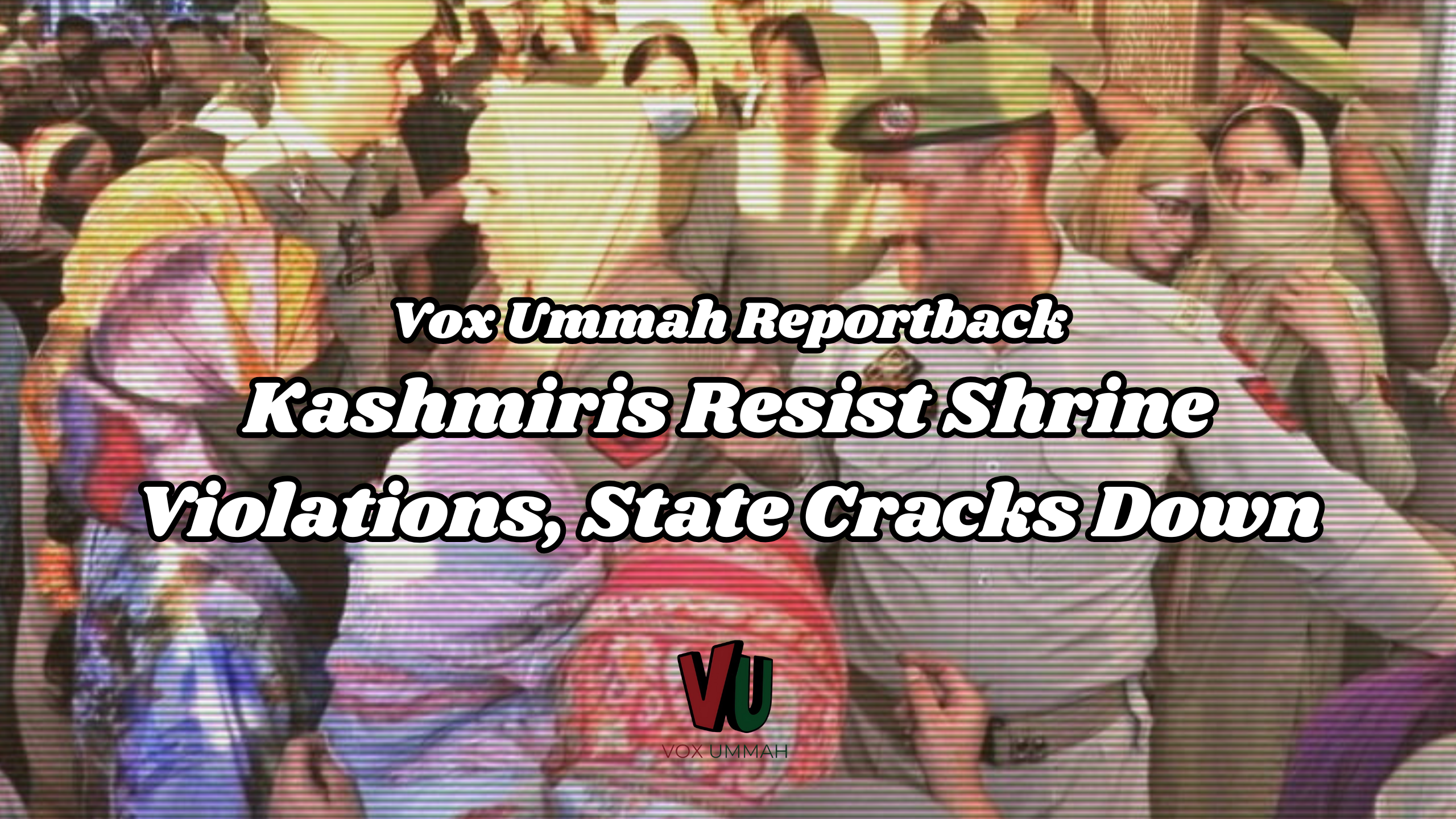
The author of this article requested that their identity remain anonymous due to security issues.
When people arrived at the Hazratbal Shrine in Kashmir for Friday prayers on September 5, they didn’t expect anything unusual. But what they saw shocked them. A sculpted plaque with the Ashoka Emblem, the symbol of the Indian state, had been placed inside the shrine.
This is the same shrine that houses a sacred relic believed to be a relic of the Prophet Muhammad (PBUH). Many felt an installation of this design was meant to cause outrage.
The plaque was smashed, as worshippers saw it not just as a piece of stone, but as a violation of their faith and beliefs.
The plaque was installed by the Jammu and Kashmir Waqf Board, which includes Darakhshan Andrabi within its leadership, a controversial figure from the ruling far-right BJP party. The party has been responsible for carrying out repression against Muslim communities, violating mosques, and disturbing practices.
Andrabi called the destruction of the emblem an “attack on the Constitution” and called for strict punishment.
Dozens of people were detained during police raids around the shrine – others were later tracked down through CCTV footage and other surveillance. A police case has been filed, and officials are considering using the Public Safety Act. This law allows someone to be jailed without trial for up to two years.
The Indian government referred to it as “vandalism.” The people who prayed there called it resistance.
Hazratbal holds significant spiritual importance to the thousands of Muslims who worship there. Imposing national symbols that violate Islamic traditions seems to have been a tactic designed to hurt and upset the worshippers.
“This wasn’t beautification. It was an attempt to show state power,” said Aga Ruhullah Mehdi, an MP from Srinagar. “Hazratbal doesn’t need the state to prove it’s important.”
Many agreed. They saw the emblem as a challenge to their faith. In Islam, especially in mosques, there is no space for statues or symbols as it is considered idol worship.
“What happened wasn’t terrorism,” said local leader Tanvir Sadiq. “It was a natural reaction to a spiritual violation.”
While the government called the act an attack on the nation, religious leaders across Kashmir said the fundamental mistake was installing the emblem in the first place. The Mutahida Majlis-e-Ulema, led by Mirwaiz Umar Farooq, strongly condemned the move.
“Hazratbal is the heart of Kashmiri Muslims. These symbols don’t belong there,” the statement read.
To many people, the emblem wasn’t just marble. It was a message to the Muslim population, which is facing new repression every day. It seemed to equate the right to practice religion with something that is regulated solely by government control. Breaking it sent a message of resistance in the face of ongoing repression.
But this story isn’t just about law and order. It’s about something more profound: identity, faith, and who gets to decide what is sacred. Analysts say the anger seen at the shrine reflects the pain many Kashmiris have felt since 2019, when India ended the region’s special status, limited political freedom, and made changes that many Muslims feel are designed to weaken their voice and status.
“Protests still occasionally erupt in Kashmir, but they are often brief and quickly suppressed. Fear of reprisal, including arrests and surveillance, discourages many from speaking out,” said a journalist based in Srinagar who did not want to be named. “The state deploys a heavy-handed response even to small street protests. The region remains trapped in a cycle of silence and suppressed resistance.”
In Hazratbal, too, the government’s response was harsh. Dozens were detained, questioned, and tracked. A police officer overseeing the investigation refused to comment on the matter.
But many are asking: what values are we defending if people can’t express their faith?
“If dissent is always seen as anti-national, where’s the space for religious freedom?” Ruhullah Mehdi asked. “This isn’t about justice. It’s about punishing people for defending what they hold sacred.”
In Kashmir, the popularly elected government formed last year lacks authority over critical areas, including law and order, policing, and religious affairs. Instead, the region remains firmly under the control of New Delhi, which administers governance through centrally appointed bureaucrats led by a governor who is a Hindu nationalist from Uttar Pradesh.
This power imbalance is evident when the local chief minister, Omar Abdullah, is questioned about incidents like the crackdown on protesters at the Hazratbal shrine. He consistently expresses his helplessness, saying, “It’s not in my hands.”
The decision by Andrabi to install the national emblem at the shrine broke with established convention, as state symbols are typically not displayed in religious sites, including Hindu temples. This concern was raised not only by politicians but also by senior Islamic scholars. Yet, it is primarily the protesters, many of them local women and youth, who face repression.
This intervention in Muslim religious affairs is not an isolated incident but part of a broader policy under the Modi government, extending beyond Kashmir to other parts of India. Just days before the Hazratbal unrest, the government refused to adjust the date of Mawlid, the Prophet’s birthday, based on Islamic moon-sighting, further upsetting the community.
Recent changes to the Waqf laws, widely seen as an attempt to undermine Muslim religious autonomy, strip the community of control over its religious and charitable endowments.
By centralizing authority and increasing state oversight of Waqf properties, the government is encroaching on a centuries-old institution that has historically allowed Muslims to manage their religious, educational, and welfare affairs independently.
Critics argue these moves aim to weaken Muslim self-governance and erode cultural and religious institutions under the pretext of reform and transparency.